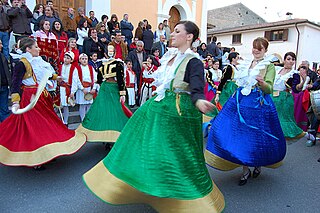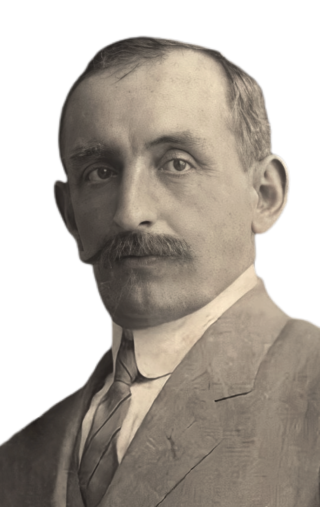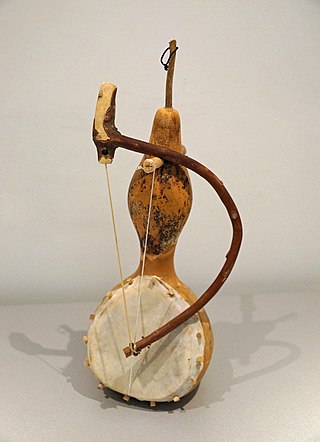Related Research Articles
E Bukura e Dheut is an epithet in Albanian mythology and folklore, used in some traditions for a crafty fairy, and in other traditions for a chthonic/earth goddess, the counterpart of e Bukura e Detit and i Bukuri i Qiellit. As a goddess of the underworld and at the same time a personification of springtime, the Beauty of the Earth is evidently an epithet of the Albanian equivalent of the Ancient Greek Persephone, which is considered to be Prende, the Albanian dawn goddess, goddess of love, beauty, fertility, health, and protector of women, also referred to as Zoja e Bukuris "Goddess/Lady of Beauty".

Prende or Premte is the dawn goddess, goddess of love, beauty, fertility, health and protector of women, in the Albanian pagan mythology. She is also called Afër-dita, an Albanian phrase meaning "near day", "the day is near", or "dawn", in association with the cult of the planet Venus, the morning and evening star. She is referred to as Zoja Prenne or Zoja e Bukuris. Her sacred day is Friday, named in Albanian after her: e premte, premtja. She reflects features belonging to the original Indo-European dawn goddess. A remarkable reflection associated with the Indo-European dawn goddess is the Albanian tradition according to which Prende is the daughter of the sky god – Zojz.
Perëndi is an Albanian noun for God, deity, sky and heaven. It is used capitalized to refer to the Supreme Being, and uncapitalized for "deity", "sky" and "heaven".
Shurdh is a name for the weather and storm god in Albanian pagan mythology. In some regions of the Albanian Alps the weather and storm god has been referred to as Rmoria or Shen Verbti; the latter is an Albanian adjectival noun meaning "the blind one" that has been used in other northern Albanian regions, to refer to the fire and wind god. In Zadrima the sky and lightning god has been called Zojz, the clear equivalent and cognate of Messapic Zis and Ancient Greek Zeus. Another possible name of the sky and lightning god could be Perëndi. The Albanian divine culture hero drangue, who plays a dominant role in Albanian mythology, features the attributes of a sky and lightning deity, apparently an Albanian reflection of the Indo-European sky god.
I Verbti is an Albanian adjectival noun meaning "the blind one", which was used in northern Albanian folk beliefs to refer to the god of fire and wind in the Zadrima region, and to the thunderstorm god in Dukagjin and the Malësia e Vogël; in Shala the thunderstorm god was referred to as Rmoria. These beliefs survived in northern Albania until recent times.

The kulshedra or kuçedra is a water, storm, fire and chthonic demon in Albanian mythology and folklore, usually described as a huge multi-headed female serpentine dragon. She is the archetype of darkness and evil, the complementary and opposing force to drangue, the archetype of light and good. The kulshedra is believed to spit fire, cause drought, storms, flooding, earthquakes and other natural disasters against mankind.

Albanology, also known as Albanian studies, is an interdisciplinary branch of the humanities that addresses the language, costume, literature, art, culture and history of Albanians. Within the studies the scientific methods of literature, linguistics, archeology, history and culture are used. However the Albanian language is the main point of research of the studies.

Worship or deification of fire, or fire rituals, religious rituals centred on a fire, are known from various religions. Fire has been an important part of human culture since the Lower Paleolithic. Religious or animist notions connected to fire are assumed to reach back to such early prehuman times.

Andon Zako Çajupi was an Albanian lawyer, playwright, poet and rilindas.

Albanian paganism comprises the pagan customs, beliefs, rituals, myths and legends of the Albanian people. The elements of Albanian mythology are of ancient Paleo-Balkanic origin and almost all of them are pagan. Ancient paganism persisted among Albanians, and especially within the inaccessible and deep interior – where Albanian folklore evolved over the centuries in a relatively isolated tribal culture and society – it has continued to persist, or at most it was partially transformed by the Christian, Muslim and Marxist beliefs that were either to be introduced by choice or imposed by force. The Albanian traditional customary law (Kanun) has held a sacred – although secular – longstanding, unwavering and unchallenged authority with a cross-religious effectiveness over the Albanians, which is attributed to an earlier pagan code common to all the Albanian tribes. Indeed, the Kanun contains several customary concepts that clearly have their origins in pagan beliefs, including in particular the ancestor worship, animism and totemism, which have been preserved since pre-Christian times. Albanian traditions have been orally transmitted – through memory systems that have survived intact into modern times – down the generations and are still very much alive in the mountainous regions of Albania, Kosovo and western North Macedonia, as well as among the Arbëreshë in Italy and the Arvanites in Greece, and the Arbanasi in Croatia.
Illyrian religion refers to the religious beliefs and practices of the Illyrian peoples, a group of tribes who spoke the Illyrian languages and inhabited part of the western Balkan Peninsula from at least the 8th century BC until the 7th century AD. The available written sources are very tenuous. They consist largely of personal and place names, and a few glosses from Classical sources.

Tomorr is a mountain chain in the region of Berat and Skrapar, in Albania. It reaches an elevation of 2,416 metres (7,927 ft) above sea level at the Çuka e Partizanit, which is the highest peak in central Albania.
Zana is a nymph-like figure in Albanian mythology and folklore, usually associated with mountains, springs and streams, forests, vegetation and animals, human vital energy and sometimes destiny. Zana e Madhe is thought to have been an Illyrian goddess, equivalent of the Ancient Greek Artemis and Roman Diana.
The drangùe is a semi-human winged divine hero in Albanian pagan mythology, associated with weather and storms. He is the archetype of light and good, the complementary and opposing force to kulshedra, the archetype of darkness and evil. Babies destined to become drangue are born with their heads covered in caul and with two or sometimes four wings under their arms. The drangue hold supernatural powers, especially in the wings and arms. A drangùe is made invulnerable by the singular conjunction produced at his birth, and can die only if this conjunction is repeated once again.

The Kângë Kreshnikësh are the traditional songs of the heroic legendary cycle of Albanian epic poetry. They are the product of Albanian culture and folklore orally transmitted down the generations by the Albanian lahutarë who perform them singing to the accompaniment of the lahutë. The Albanian traditional singing of epic verse from memory is one of the last survivors of its kind in modern Europe, and the last survivor of the Balkan traditions. The poems of the cycle belong to the heroic genre, reflecting the legends that portray and glorify the heroic deeds of the warriors of indefinable old times. The epic poetry about past warriors is an Indo-European tradition shared with South Slavs, but also with other heroic cultures such as those of early Greece, classical India, early medieval England and medieval Germany.

Enji is the old name of the fire god in the Albanian pagan mythology evidently contained in the week day name that was dedicated to him – e enjte – the Albanian word for Thursday. The Fire – Zjarri – is deified in Albanian tradition as releaser of light and heat with the power to ward off darkness and evil, affect cosmic phenomena and give strength to the Sun, and as sustainer of the continuity between life and afterlife and between the generations. The divine power of Fire is used for the hearth and the rituals, including calendar fires, sacrificial offerings, divination, purification, and protection from big storms and other potentially harmful events. Fire worship and rituals are associated with the cult of the Sun (Dielli), the cult of the hearth (vatër) and the ancestor, and the cult of fertility in agriculture and animal husbandry. Fire rituals that are commonly found among Indo-European peoples, including the Albanians, have been firstly attested by the Vedas, with hymns dedicated to the fire god Agni. Described in written sources since 1482, the Albanian fire rituals have been historically fought by the Christian clergy, without success. The cult of the mystic fire and the fire ritual practices have played a prominent role in the lives of all the Albanian people until the 20th century, and in rural areas they continue to be important for Albanian traditional customs even in the present days.
Perria or Pehria is a fairy-like mountain figure in Albanian mythology and folklore.

Zojz is a sky and lightning god in Albanian pagan mythology. Regarded as the chief god and the highest of all gods, traces of his worship survived in northern Albania until the early 20th century, and in some forms still continue today. The old beliefs in the Sky are pagan beliefs preserved by Albanians since ancient times. In Albanian the god who rules the sky is referred to as i Bukuri i Qiellit, a phrase that is used in pagan contexts for the Sun (Dielli), worshiped as the god of light, sky and weather, giver of life, health and energy, and all-seeing eye. The sacred significance of one of the main symbols of the sky cult – the eagle – has been scrupulously preserved by Albanians, who have always considered it their animal totem. An epithet considered to be associated with the sky-god is "father", thought to be contained in the Albanian noun Zot, used to refer to the supreme entity. A remarkable reflection of Proto-Indo-European mythology associated with the dawn goddess *H₂éwsōs is the Albanian tradition according to which the dawn goddess – Prende – is the daughter of the sky god – Zojz.
E Bukura e Detit is a character in Albanian mythology and folklore, depicted in some traditions as a sea-fairy / nymph, and in other traditions as a sea goddess, the counterpart of e Bukura e Dheut and i Bukuri i Qiellit. In some Albanian traditions she is regarded as the sister of e Bukura e Dheut.

Dielli, the Sun, holds the primary role in Albanian pagan customs, beliefs, rituals, myths, and legends. Albanian major traditional festivities and calendar rites are based on the Sun, worshiped as the god of light, sky and weather, giver of life, health and energy, and all-seeing eye. In Albanian tradition the fire – zjarri, evidently also called with the theonym Enji – worship and rituals are particularly related to the cult of the Sun. Ritual calendar fires or bonfires are traditionally kindled before sunrise in order to give strength to the Sun and to ward off evil. Many rituals are practiced before and during sunrise, honoring this moment of the day as it is believed to give energy and health to the body. As the wide set of cultic traditions dedicated to him indicates, the Albanian Sun-god appears to be an expression of the Proto-Indo-European Sky-god.
References
- 1 2 3 4 Lurker 2005, p. 186.
- 1 2 3 Elsie 2001, pp. 252–254.
- ↑ Mallory & Adams 1997, p. 147.
- ↑ Elsie 2001, p. 253.
- ↑ Elsie 2019 , p. 169–170; Elsie 2000 , p. 39; Hasluck 2015 , p. 180; Bulo 1997 , pp. 3–7; Clayer 2017 , pp. 139.
- ↑ Çabej 1996, p. 212.
- ↑ Cook 2010, p. 1171.
- ↑ Fishta & Lambertz 1958 , p. 284
- ↑ Lurker 2005 , p. 38